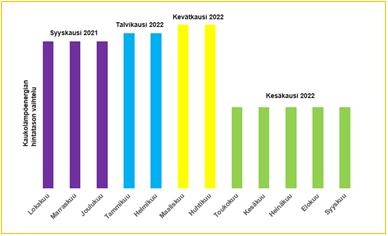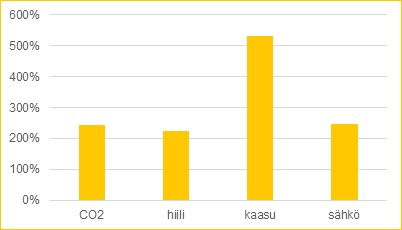Helen’s district heat prices to level off by the summer
District heat has four price periods that are tied to the seasons. The total price of the district heat product in the winter and spring will remain close to the autumn 2021 price level and fall in the summer season of 2022. Helen has significantly softened the price impact to the customers resulting from the exceptionally high raw material prices and emission allowances, and it is expecting the upward pressure on prices to level off by the summer season 2022.
The total price of district heat consists of the fixed water flow fee and the seasonal energy fee. The fixed water flow fee accounts for about a quarter of the total costs, and no changes will be made to its prices. The energy fees are subject to cost pressure, and they are updated four times a year: at the beginning of January, March, May and October. For next year, Helen offers a longer outlook for district heat product customers by publishing the prices for three price periods at the same time. The total price of the district heat product for consumer customers will rise by 15 per cent for the winter, spring and summer season 2022*. The price increase for housing co-operative and business customers will be a few percentage points higher due to the greater share of customers’ energy fees in the total price. Helen’s price changes will not be added on top of the price announced for the autumn season 2021, but they will be compared to the corresponding seasons in the previous year.
“The strong increase in the cost level of the energy proportion of district heat manifested itself for the customers for the first time in the summer season 2021. Unfortunately, the same increased price level will also continue in the early part of next year. We understand that the price rise, which increases essential living costs, is a significant burden for Helsinki residents with district heating. However, we expect the significant increase in the cost level to be a temporary phenomenon and that the customer prices will level off by the summer season 2022,” says Anu-Elina Hintsa, Helen’s Senior Vice President, Sales & Customer Service.

Image 1. The energy price of district heat is tied to four seasons.
The rise in the energy fee of district heat is due to the increase in excise duty at the turn of the year 2021, as well as the exceptionally strong growth in the price of fuels, emission allowances and electricity at the same time. For example, the global prices of a critical fuel in heat production, natural gas, have risen by a huge 530 per cent between the winter seasons of 2021 and 2022. Helen will not transfer the costs of the energy price rise to the district heat customer prices in full, but has significantly softened the price impact of the exceptionally high raw material prices and emission allowances. Helen emphasises that the total price of district heat is always compared to the corresponding period in the previous year. The forthcoming 15 per cent increase in total price will therefore not be added on top of the increases notified for the summer and autumn seasons 2021 but, for example, the winter season 2022 is compared to the winter season of 2021.

Image 2. The market prices of emission allowances, coal, natural gas and electricity have risen to an exceptional degree compared to the 2021 winter season.
Active measures to break the price increase
Helen is taking constant measures to break the district heat price increase for customers already in the short term, although extra pressures are mounting from the markets. Helen has accelerated the transition to carbon-neutral energy production and is currently looking to bring forward the phasing out of coal-fired power generation in the Salmisaari power plant already in 2024. The Hanasaari coal-fired power plant will close in spring 2023. The Vuosaari bioenergy heating plant will be commissioned in the heating season of 2022–2023, and the seventh heat pump in the Katri Vala heating and cooling plant will be completed in 2023. The investments will reduce the use of fossil fuels.
“District heat is turning carbon neutral. We already offer renewable district heat to our customers. Next year, there will be a reduction of more than 50 per cent in the additional fee of renewable district heat when our renewable production grows. Renewable district heat is also available to individual residents in a housing company,” Hintsa explains.
District heat customers can also choose the Fixed-Priced District Heat product. A fixed price brings stability to budgetary planning, and the customer gets a clear and predictable outlook to the price of heating energy for the next three years.
“The currently published three-year fixed energy prices of district heat send out a positive message that the upward pressure on prices will ease off,” Hintsa points out.
District heat of the future will be a renewable and economically sustainable alternative
Helen’s district heat is on its way to being carbon neutral. In the future, Helsinki will be heated with distributed energy production where energy is recovered from various different sources: from the earth, air, water and waste heats. For Helen, the price pressure on district heat produced with fossil fuels is a temporary phenomenon because renewable energy is not under the same cost pressures as fossil production.
Helen offers various district heat products
The district heat products offered by Helen to consumers, housing companies and businesses:
- District heat. District heat is a reliable, secure and easy heating solution for both new and old properties. District heat heats the space and tap water effortlessly, and the temperature remains stable regardless of the outdoor temperature. District heat has four annual price periods when the product’s energy fee is updated.
- Renewable district heat for consumers. Renewable district heat is an easy climate deed for district heat residents in Helsinki. Renewable district heat offers district heat produced with renewable energy sources for an extra fee of only a few euros per month for both apartment blocks and detached houses.
- Fixed-priced district heat for housing companies. Fixed-priced district heat brings stability to heating costs. It offers a clear and predictable outlook to the price of heating energy for three years ahead.
- Renewable district heat for housing companies and businesses. Renewable district heat promotes climate-neutral heat production and reduces the property’s carbon dioxide emissions immediately without any changes to the heating system. The production of renewable district heat utilises wood pellets produced as by-products of industry.
- Recycled Heat for businesses. Recycled Heat is a 100% emission-free heat product, which is distributed via the district heating network. With Recycled Heat, the property’s heating is easily updated to fully carbon neutral without renovation. Recycled Heat is produced, e.g. from waste heat collected from, e.g. data centres, substations, waste water and industrial processes.
*) Finnish Energy’s standard detached house, energy consumption 18 MWh/year, water flow 0.15 m3/h.
Lisätietoa kaukolämmön hinnoista.